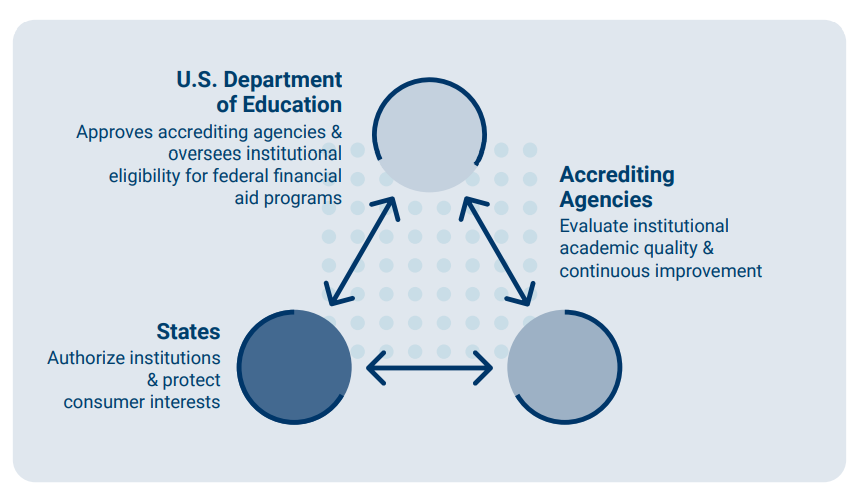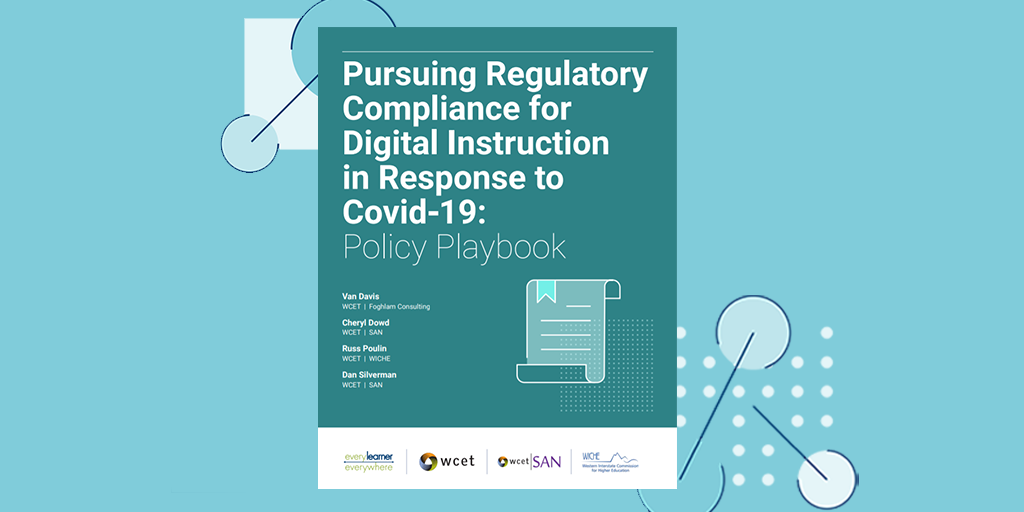Idea in brief:
This article aims to help college and university faculty understand the complex regulatory issues that new distance learning programs must account for. It summarizes for faculty a new comprehensive policy playbook written for administrators.
While college and university faculty are planning new courses and programs, they may not be aware that administrators are anticipating how they must guide the program through a maze of complex regulatory requirements. This is especially important as virtually every higher education institution is reworking its educational model in substantial ways in response to the COVID-19 pandemic.
Because it has been necessary to launch online courses and programs quickly, many (but not all) regulatory requirements have been waived or temporarily suspended, but administrators have to maintain documentation of the changes they are making and may eventually have to submit these programs for regulatory review.
The numerous organizations that colleges and universities must answer to can be summarized as the “regulatory triad.” This model is presented in a new policy publication, Pursuing Regulatory Compliance for Digital Instruction in Response to COVID-19: Policy Playbook. This comprehensive 74-page guide was developed by WCET — The WICHE Cooperative for Educational Technologies, in partnership with Every Learner Everywhere.
The playbook covers accreditation, federal financial aid rules, state authorization, professional licensure, course-level record-keeping requirements, and student civil rights. In each section readers will find a guide to common regulations, whether or not they are suspended or waived in response to the COVID-19 crisis, the potential impact on the institution of noncompliance, and recommended procedures that institutions put in place during this transition to digital learning. It also includes a guide to helpful resources.
For a quick illustration of how the regulatory issues can matter to an institution, imagine a traditional face-to-face program that is transitioning to online delivery and consider these two questions: In the new format, does how often an instructor and a student interact directly change, and does the process for keeping records of student attendance change? If so, each of those can have far-reaching ripple effects on the regulatory issues that higher education administrators manage.
While the playbook is written for administrators, this article summarizes its content for faculty to help them understand how their curricular design — particularly when it involves distance learning — will ultimately intersect with the regulatory issues administrators focus on.
The regulatory triad
In theory, a college or university can launch any kind of program it wishes and let the market judge if it is a quality program. In practice, however, an academic program is unlikely to succeed if academic credits from that program aren’t recognized elsewhere and if students can’t use federal financial aid money to pay for it.
That’s where a stamp of approval from outside reviewers comes in. Accrediting agencies reassure employers, graduate schools, and licensing bodies that graduates came from a quality program. The U.S. Department of Education (ED) ensures that a program is eligible to receive a student’s financial aid dollars.
Every region and state in the U.S. has a slightly different mix of agencies that govern higher education, but the policy playbook uses the “regulatory triad” to illustrate the combination of federal regulators, accreditors, and state regulators that are generally involved.
The U.S. Department of Education (the Department): The Department has two key roles. First, it ensures the integrity of the $54 billion financial aid system by reviewing for institutional compliance with financial aid regulations. In that role, it looks primarily at institutional capacity and financial responsibility.
Second, it has approval oversight of the system of independent accrediting agencies that assess quality. The Department doesn’t review academic quality directly.
Accrediting agencies: Accreditors oversee academic quality at the institutional level.
The standards used by accrediting agencies vary, but the Department only recognizes an agency if it adheres to a set of minimum standards. Occasionally, the Department ceases recognition of an accrediting agency, putting in jeopardy the financial aid of students attending all the colleges and universities accredited by that agency.
Many professional associations also deliver program-level accrediting that a department within a college or university may choose to participate in. Some programmatic accreditations are required in programs leading to professional licensure such as nursing, medicine, education, and law. Other program-level accreditations that are available may not be required but are pursued as a marker of excellence and to give strategic direction to the program.
States: Each U.S. state sets its own laws for ensuring consumer protection. In order to receive federal financial aid, institutions must be authorized to do business in the state or states in which they operate. (See more below on how regulations impact an online program serving students in multiple states.)

Credit: Pursuing Regulatory Compliance for Digital Instruction in Response to COVID-19: Policy Playbook, WCET, WCET SAN, and WICHE in partnership with Every Learner Everywhere, 2020
Between these three legs in the triad, under normal circumstances, college and university programs are frequently examined, sometimes by more than one body, for their quality, alignment around mission, financial viability, governance structure, and administrative procedures.
In this period of accelerated change to how education is delivered, administrators must still account for a large number of regulatory requirements. The rest of this article outlines a sample of them.
Institutional and programmatic accreditation of distance learning
The approval to offer distance education is usually a multi-step process that involves the institution’s accreditor as well as the Department. In response to the COVID-19 crisis, the Department granted broad approval of distance learning through December 31, 2020.
However, colleges and universities must still contact their accrediting agency to determine if they have any other conditions that an institution must meet before adapting an existing program to an online format or launching a new program.
And no one can say what will happen after this waiver period when, presumably, most new distance programs will still be offered. In anticipation of that period, the policy playbook advises colleges and universities to:
- check with their accreditor, since they haven’t all responded identically and consistently to the waivers that the Department permit them to extend;
- endeavor to meet the accreditor’s existing quality standards on the assumption that they will be reviewed against those standards eventually; and
- document every program change. If institutions want to continue offering online instruction after the end of the waiver period, they may need to solicit the Department or accreditor for approval to continue.
Financial aid eligibility and distance learning
To remain eligible to receive payment from students using federal financial aid funds, an institution must comply with several regulations involving learning modality, satisfactory academic progress of students, and interactions between students and instructors. Administrators will be concerned that new online programs don’t stumble on any of these issues, since being out of compliance can jeopardize the institution’s finances.
One of the first issues administrators will be concerned with is if a program meets the Department’s definition of “distance education” as opposed to a “correspondence course.” Students in the latter are eligible for far less financial aid. The amount of interaction between students and faculty is a critical part of the definition. (See pg. 21 of the policy playbook for a fuller explanation of the distinction between a correspondence course and distance education.)
The Department has not waived or suspended any of the guidelines related to defining distance education.
Second, administrators will be concerned that structures are in place to track a student’s last date of attendance, as that can have an impact on how much financial aid a student is eligible for. It’s not uncommon for the Department to require a college or university to refund financial aid resources it collected if it cannot document attendance.
The Department has not waived or suspended any of the regulations related to attendance tracking.
Third, a program must also be able to track a student’s satisfactory academic progress (SAP) by evaluating a student’s standing, since academic standing impacts the financial aid a student is eligible for.
It is up to the institution to calculate SAP, but they do have some relief from Congress and from the Department in response to the COVID-19 emergency. The CARES Act allows an institution to ignore credits impacted by the pandemic when it calculates SAP, and the Department extended a waiver through the end of this year in how pass/fail courses are used in the calculation.
There are numerous other financial aid regulations that administrators must keep an eye on, and the policy playbook touches on two:
- The Department of Veterans Affairs has made the eligibility rules for GI Bill benefits more lenient during the crisis.
- The Department has temporarily waived some requirements affecting multi-institution consortia, which can have complex arrangements for distributing financial aid.
State authorization for distance education
More online education means more programs that serve students in multiple states. Since states have oversight authority for education within their borders, an institution offering online courses may be responsible for gaining approval in other states where students are located. Approval to operate in other states is managed through the State Authorization Reciprocity Agreement.
That complexity hasn’t necessarily eased during the COVID-19 crisis. Some states are offering emergency approval processes for institutions from other states, but not all are.
Other regulatory issues impacting new distance learning programs
The aforementioned are only some of the regulatory issues that college and university administrators must account for as programs are substantially adapted for online delivery or as new programs are developed. Other issues include:
- Professional licensing. States oversee most licensing, and the mode of instructional delivery may impact whether or not a program is in compliance and if graduates will be eligible for licensing. Federal law requires that institutions communicate to students if a curriculum meets licensing requirements, and the Department hasn’t waived or suspended that requirement.
- Academic integrity. Regulations require a process to verify that the student enrolled in a course is the same person who did the work. The Department has temporarily given accreditors the authority to waive their accrediting requirements related to student identity verification, but not all accreditors necessarily are waiving the requirements.
- Other disclosures. Institutions must disclose costs at the time of enrollment, and new online course activities may have new costs such as proctoring. There have been no waivers of these requirements.
- Copyright law. The boundaries of the “fair use” doctrine of copyrighted materials in education may be less clear in digital learning environments. The rush to create and distribute digitized course materials, if they violate the fair use doctrine, can expose institutions to copyright lawsuits. There have been no waivers of copyright laws.
- Accessibility. Regulations regarding accessibility for disabled students apply to online learning. This may mean a college or university needs more technology capacity or clear processes for creating special accommodations. The Department hasn’t waived any of these guidelines or regulations.
- Title IX. Colleges and universities may need to create new processes for receiving and responding to Title IX sex disrimination complaints from students in online learning environments.
- Privacy. New distance learning programs mean colleges and universities may need to update processes for protecting personally identifiable information. There have been no waivers of privacy regulations.
In short, the decision to adapt or design a curriculum for distance learning is one part of a complex administrative process governed by a network of accrediting agencies (both institutional and programmatic level), the U.S. Department of Education, and the laws of potentially multiple U.S. states.
Experienced online instructors understand that they can’t uncritically duplicate the policies, readings, and assignments from face-to-face classes into an online format. Similarly, administrators can’t assume the procedures in place for tracking quality, attendance, and student aid funds will automatically work smoothly as more classes are delivered online.
Download: Pursuing Regulatory Compliance for Digital Instruction in Response to COVID-19: Policy Playbook.



